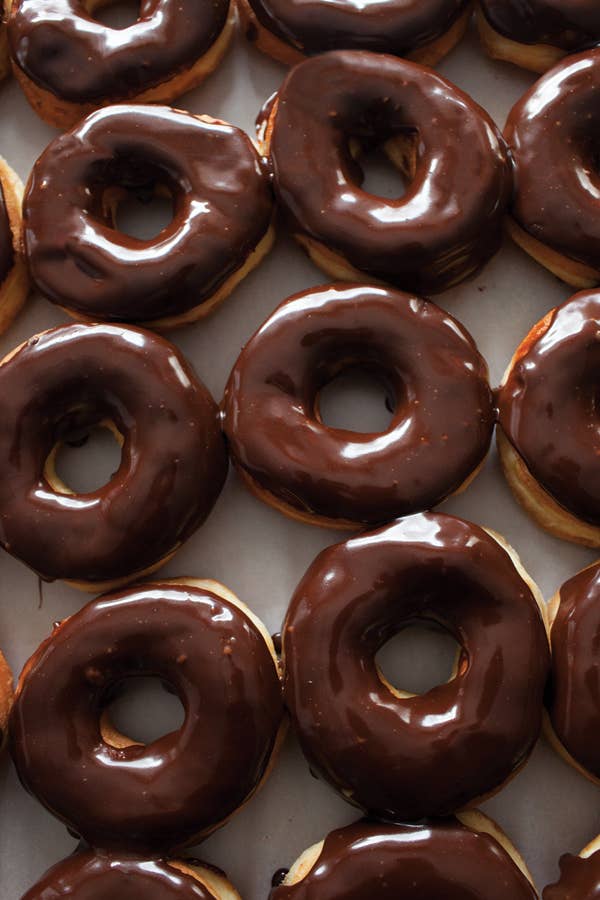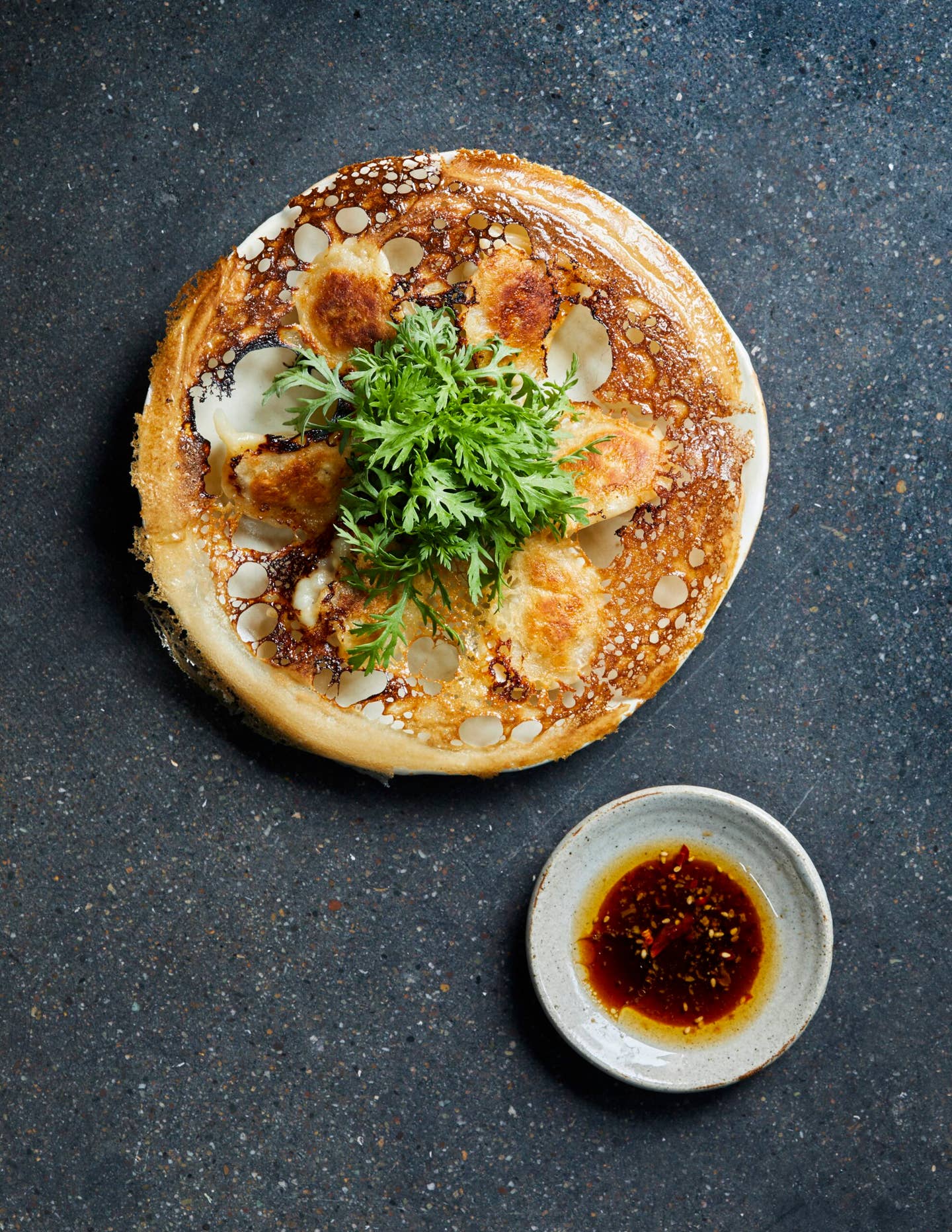
Donut Planet
From European festival food to blue-collar American breakfast, our nation’s favorite sweet has taken on many forms throughout its history. Each one, whether it’s a sticky jelly-filled donut or an airy chocolate glazed, is thoroughly, compulsively, delicious.
On a recent monday morning, Peter Pan Donut & Pastry Shop in Brooklyn was open barely 15 minutes, and the crowd waiting to buy fresh donuts had already spilled out the door. At the front of the line, half a dozen cops ordered their first meal of the day: hefty, craggy old-fashioneds and coffee. Next, the local pharmacy manager requested tea and a single glistening chocolate glazed. Then a young couple glanced up from their cellphones just long enough to get a red velvet cruller and a toasted coconut. When my turn came, I asked for one whole wheat, one red velvet, and a cup of coffee, slipped past the others to the worn Formica counters, and settled in.
Peter Pan makes the quintessential American donut. The whole wheat is sweet, soft, and cakey; rich without being greasy; its lumpy form dissolving into delicate crumbs with every bite. I convinced myself that whole wheat is healthy, but I couldn't kid myself about the red velvet. It's pure crimson-colored indulgence and should probably be outlawed this early in the morning. But that would surely be unconstitutional. Sugary, utterly satisfying, and just right for dunking in black coffee, it's an insanely addictive all-American breakfast. I polished it off without a second thought.
I wasn't always such a fan of these stateside staples. I grew up in Prague, where my childhood donut was a jelly-filled raised kobliha. I remember a giant airy pillow, juicy with apricot jam and covered with a sneeze-inducing blanket of powdered sugar. Compared to this bliss, my first encounter with an American donut left much to be desired: The pastry came out of a box and tasted of cardboard. For years afterward, I wrote off the donuts of my adopted home.
I had to wait until adulthood for my American donut epiphany. My girlfriend and I had rented a car for an autumn road trip through New England. We ticked off the cliches from our list: the white steeples, the electric foliage, the farmers' markets piled high with pumpkins and apples. At one roadside stand there was an automated donut-making gizmo that saturated the air with the smell of cinnamon sugar and fresh fried dough. Despite my prejudices, I couldn't resist. What came out of that machine were perfect cider donuts, warm enough to take away the autumn chill, sweet enough so I couldn't stop at just one, crusty on the outside and tender within. Since that day, I've had a hard time resisting a cider donut—or any other fresh donut, for that matter.
While I adored the Czech jelly donuts I was weaned on, I discovered over time that for sheer ubiquity and cultural presence, neither they nor their cousins held a candle to the American donut. Though donuts take on countless shapes, textures, and forms around the globe (see "A World of Donuts"), it's in America where these fried cakes came of age. How did the pastries of my European youth become a quotidian American treat? And why is this snack so very beloved on these shores? As it turned out, I ended up writing a book about it to fully understand. My search took me on a delicious journey all the way from the biblical past to the most innovative donut shops of today.
The first thing I learned is that just about every civilization has some type of donut. The role that they played, however, came as a delightful surprise. Far from being a mere indulgence, many of these treats were imbued with a near mysticism. For much of history, deep-fried dough was considered sacred and celebratory. Perhaps the earliest written mention is in the book of Leviticus, specifying "cakes mingled with oil, of fine flour, fried" as an offering worthy of God.
As fat and oil were costly, frying was the mark of a party. In medieval Europe, donuts were what you gorged on during Carnival, the feast period before the 40 days of Lent. It stands to reason that the prohibition against eating meat during Lent would have extended to donuts, which were then fried in hog fat. As every good Catholic knows, you need to sin before you can repent, and it became almost mandatory to eat as much forbidden food as possible before the door to the larder slammed shut. What better way to use up all the fat on Fat Tuesday than to fry some sweet dough?
With a little binge of my own in mind, I visited Austria's mountainous Tyrol region, one of the many places in Europe, I had heard, where they partake in that pre-Lenten tradition. I was not disappointed. When I got off the train, I was greeted with tables groaning under mountains of faschingskrapfen, carnival donuts in German, beckoning beneath a blizzard of sugar. Stands were loaded down with plump jelly donuts, and others filled with flavors such as custard, chocolate creme, and eiercognac, a boozy eggnog. By the end of my first day, I was covered with powdered sugar.
Jelly donuts dunked in glaze at Dat Donut in Chicago
The more I explored, the more I saw the connection between donuts and holy days repeated throughout Europe, India, Asia, and Africa, among Hindus, Muslims, and Jews. In America, by contrast, donuts were embraced as an everyday food. Here, they took on the moniker "donut," the first donut machine and chain store were spawned, and the treat became breakfast, as well as a snack to be eaten at any time.
Some say donuts, in the form of sweet fritters called olykoek, landed with the Dutch in New Amsterdam. Other evidence—stronger, in my opinion—points to New England, where I had my American donut conversion. There, the donut was divorced from its Old World past. In America, Protestant settlers could ditch the Catholic holidays and enjoy fried cakes whenever they wanted. Meat, and thus cooking fat, was abundant, so it was easier than ever to indulge. By the late 18th century, donuts were common enough to be sent as a snack into the fields during haying season. In 1803 the first printed recipe for them appeared in Sussannah Carter's The Frugal Housewife.
In early donut recipes like this one, which calls for yeast-leavened dough enriched with sugar, eggs, and butter or lard, I saw a whisper of the ethereal donuts that are peddled at Krispy Kreme today. Though early versions were holeless and small enough to fit in your pocket, they were still fundamentally yeast-raised donuts. What better name for these crispy mouthfuls, which were roughly the size of a walnut, than "dough nuts," as it was then spelled?
Then there was the cake donut. Dense and crumbly where yeast donuts are airy and bouncy, these creations—progenitors of today's chocolate rings and rough-hewn old-fashioneds—caught on in America like nowhere else. It turned out Americans had been using baking soda in cakes since the earliest days of the republic, but it must have been a stroke of Yankee ingenuity to apply it to a donut. The earliest recipe, a mixture of flour, sugar, eggs, and butter with pearlash (a potassium carbonate predecessor to baking soda) mixed in for lift, appeared in an 1830's cookbook by Boston-based Lydia Maria Child. Compared to yeast donuts, which take time to rise, cake donuts are quick: You just add a chemical leavener and fry right away.
One of my favorites, the cruller, was around in those early days, too. Shaped into loops or twists, these donuts reflected their name, an old English (or Dutch) variant of "curl." But the early cruller was more like a fried cookie, quite different from the wonderfully eggy choux pastry "French cruller" we eat today.
It's entirely uncertain when the cruller, or any American donut, got its hole. The oldest recipe I could find for a ring-shaped donut is from 1846, in The Skillful Housewife's Book by a Mrs. L.G. Abell, who calls for her "Excellent Common Fried Cake" to be "cut as jumbles"—the term for a ring-shaped pastry—"or in strips, and twisted, and fried in lard." Cutting a hole out of the center, I learned, not only gives the donut its iconic look, it also serves a function, allowing the dough to cook more evenly and faster than a donut without one.
So how did donuts become the quintessentially American food that they are today? By the mid-19th century, donuts were not only evolving, they seemed to be everywhere. Yankee soldiers battling the Confederacy were dispatched with donuts. Miners in the roaring '90s woke up to them. New arrivals to the promised land were indoctrinated in the cult of the sinker, midcentury slang for donut. When immigrants landed at Ellis Island they were greeted with donuts, as if to say, in America every day is feast day. During World War I, American soldiers got a taste of mom's cooking from Salvation Army "lassies," who handed out donuts. By the second World War, those donuts were produced from a mix and spewed out by Rube Goldberg-esque contraptions, both provided by the Donut Corporation of America. Its founder, Adolph Levitt, invented the first automated donut machine in 1921, and introduced the world to premade donut mixes, which changed the donut landscape forever.
Levitt's Wonderful Almost Human Automatic Doughnut Machine churned out 80 dozen donuts an hour and was relatively inexpensive, making it possible for would-be entrepreneurs to open "sinker and suds" joints, and led to the advent of the American donut chain. As shops proliferated, one way they distinguished themselves was by dreaming up new flavors. "The typical store had only four kinds of donuts: plain cake, jelly, yeast-raised, and a cruller," wrote William Rosenberg, founder of Dunkin' Donuts, in his memoir Time to Make the Donuts. "I wondered, 'Why can't we make 28 or 52 or 108 varieties of donuts?'" Some of the flavors that emerged during that time are among my favorites: the classic chocolate-glazed and over-the-top Boston creme.
Donuts were becoming widespread, commonplace, even egalitarian. Many shops were open 24 hours, which made them magnets for cops, truck drivers, and other denizens of working-class America. In 1929 Americans ate 216 million donuts. Today, by one count, we eat close to 10 billion a year. As the once homespun food became a big business that hinged on mass production, it seemed only natural that a trend would emerge that I, for one, welcome: the small batch, upscale donut (see "Donut Renaissance," page 53).
In recent years, pastry chefs at fancy restaurants and bakers at artisanal donut shops have been applying fine ingredients, creative plating, and flavors such as Valrhona chocolate, creme brulee, and foie gras to the previously humble donut. I even came across a vegan-organic donut shop, Pepples Donut Farm in Oakland, California, owned by a former punk musician, Josh Levine. In the spirit of this fried dough revolution, he calls one of his many ingenious creations the "WTF donut," a cake donut named for its blend of whiskey, bright tangerine, and fig glaze—a combination at once playful, decadent, and balanced.
Some might quibble that there's no need to mess with perfection, but as far as I'm concerned, when it comes to donuts, more is more. One thing that Levine told me that day about donuts still sticks with me: "They transcend all barriers." It's true, and it's good to know that there's something Oakland vegans and Brooklyn cops can agree on: If there's one thing we have in common as Americans, it's our love of the donut.
All of my fried dough adventures finally got me to take the plunge and start making donuts in my tiny Manhattan kitchen. My shiny new deep fryer took up half the counter, but it left just enough room to mix my first batch of cider donuts. I shaped the rings by hand, then lowered them with anticipation into the hot fat. Bobbing and brown, they were the prettiest pastries you'd ever want to see. Once they were puffed up and golden all over, I fished them out with a slotted spoon, drained them, and tossed them in cinnamon sugar. I won't admit how many I ate. Hot from the fryer, the donuts had a delicacy that elicited all the pleasures of childhood, and the warm sweet treats were better, even, for all I had learned about them.
Keep Reading
Continue to Next Story










